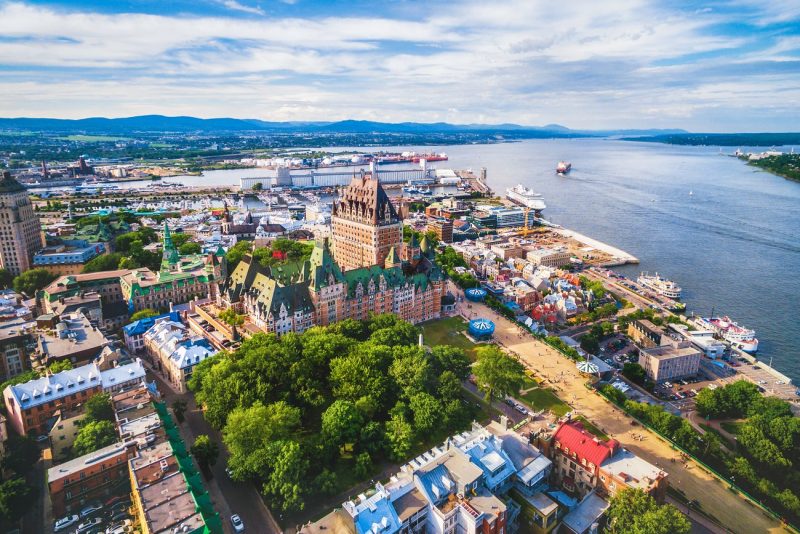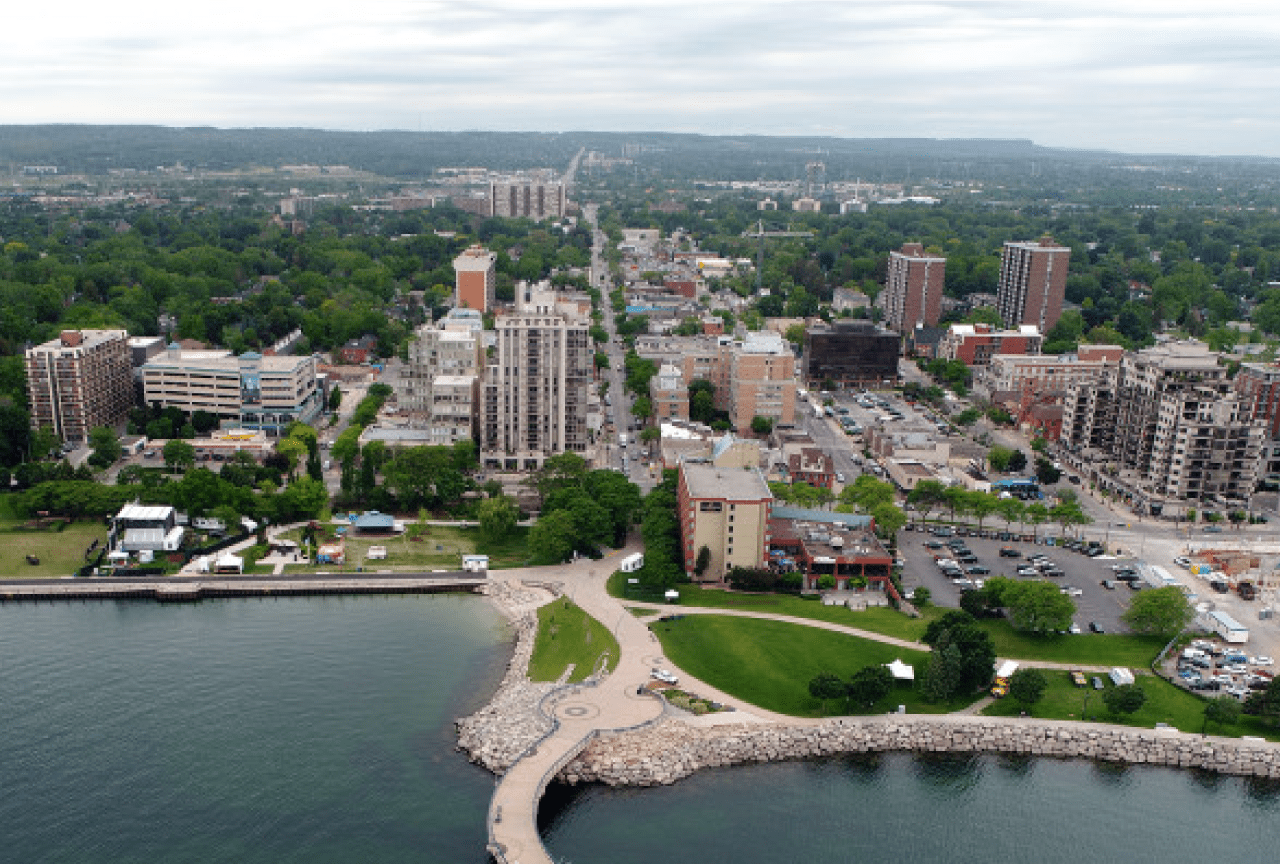Are you looking for information on the best areas to stay in Montreal? So that you can make an informed choice, we have compiled the most popular areas to sleep in Montreal, along with their most outstanding points of interest and some indications about accommodation in each of them.
Located on an island in the St. Lawrence River, Montreal is the largest city in the Canadian province of Quebec. Named for the triple-peaked hill Mount Royal, Montreal is a city with a history as rich as it is constantly evolving.
First inhabited by First Nations peoples 4,000 years ago, Montreal would go on to become a prominent French settlement and eventually a cosmopolitan metropolis with more than 1.7 million inhabitants.
The possibilities for things to do and see in this Canadian city are endless: foodies, shoppers, culture buffs, and history devotees will find plenty to keep them entertained.
From the centuries-old streets of Old Montreal to the vibrant Downtown, Montreal is a city that people like and that will surely dazzle you too.
The best areas to stay in Montreal
1. Old Montreal, the best area to stay in Montreal
This impressive historic neighborhood dates back to the early 17th century. It is an area whose visit is essential in any trip to this city. Old Montreal will immerse you in the fascinating history of the city.
Located near the banks of the St. Lawrence River and spanning several cobblestone blocks, it is brimming with landmarks, markets, museums, shops, architectural treasures, and some of the best bars and restaurants in the city.
The Place d’Armes is an ideal place to start your visit. Here are buildings such as the old Bank of Montreal or the impressive Aldred and New York Life buildings, in an art deco style.
To the south is Notre-Dame Basilica, where none other than musical legend Céline Dion herself married.
Visitors can admire the Montreal City Hall, erected between 1872 and 1878 by Alexander Cowper Hutchison and Henri-Maurice Perrault and inspired by the Hôtel de Ville Tours of France.
The nearby Bonsecours market dating back to 1847 is another must-see. In this market, you can browse and buy its endless supply of art, clothing, jewelry, antiques, and specialty items made in Quebec.
From there, take a stroll down Montreal’s oldest street, Saint-Paul, which offers some of the city’s most popular sights, as well as plenty to do and see along your walk.
Along with numerous shops, galleries, and restaurants, Rue Saint-Paul eventually becomes Place Jacques-Cartier, named after the French explorer who claimed Canada for France in 1535.
History buffs will want to visit the Pointe-à-Callière, a museum dedicated to the history and archeology of Old Montreal, from the original peoples to eventual European colonization.
The museum is even housed in an excavated archaeological site that visitors can walk through and fully immerse themselves in.
The Château Ramezay, built in 1705, is also an interesting visit, as it was the first building in Quebec to be recognized as a historic monument, and it also houses a museum dedicated to the early days of the city.
If this area to sleep in Montreal catches your attention, you will not be short of accommodation options, both in the neighborhood and in its surroundings, many of which are located in centuries-old buildings and residences.
Due to its great popularity, Old Montreal can be a bit prohibitive for the humblest of pockets. If you are looking for cheap accommodation in Montreal, you will have more options in other neighborhoods.
2. Downtown, to sleep in Montreal in the heart of the city in a neighborhood that has everything
If Old Montreal is the soul of the city, Downtown is undoubtedly its nerve center. University students, workers, and shoppers gather in this lively district and mingle in the many chain stores, malls, bars, restaurants, and establishments that populate its street.
For shopping, a reference address is Rue Sainte-Catherine, while Crescent Street is perfect for a cocktail after shopping.
The Museum of Fine Arts, with more than 41,000 works from around the world, as well as the historic McCord Museum, are two notable stops that are worthwhile.
Lovers of the curious and the macabre will be in their element at McGill University’s Redpath Museum, a natural science museum that displays everything from shrunken heads to Egyptian mummies to dinosaur bones.
Downtown is also home to Montreal’s Chinatown, easily recognizable by its impressive gates.
An attraction not to be missed is the Montreal lookout, Au Sommet PVM, located on the 46th floor of the Place Ville-Marie office building and shopping mall.
Here you can enjoy the best views of the city. You’ll also get to see an interactive exhibit and perhaps eat at Montreal’s highest restaurant, Les Enfants Terribles, located on the 44th floor.
Foodies will be overwhelmed by what this area of Montreal has to offer, with every style of food imaginable, including countless food trucks, bakeries, and specialty markets.
Since the city center hosts a good number of festivals and events throughout the year, from the summer Jazz Festival to the winter shows, you can be sure that if you choose Downtown to sleep in Montreal, your stay will be anything but boring.
You will find a good number of hotels, hostels, and private rentals in the center and its surroundings, with prices that vary according to the season.
3. Plateau Mont-Royal, where to stay in Montreal for families and couples
The laid-back Plateau Mont-Royal neighborhood is known for its student vibe and idyllic row houses, making it a great spot for families and couples looking for a more intimate setting.
With its many bars, cafes and a variety of restaurants, Plateau Mont-Royal is the perfect destination for a date night, with plenty of theatres, galleries, and venues with musical or cultural events to round out the night.
Mount Royal Park is a perfect place to stroll with lake and mountain views providing a truly unforgettable backdrop.
There is also Parc Sir-Wilfrid-Laurier, famous for its beautiful gardens, towering trees, sports fields, and even a public swimming pool.
When you’re ready to explore the neighborhood further, the Écomusée du Fier Monde, a former Art Deco-style public bathhouse and museum, awaits you.
Here visitors can explore the lives of Montreal’s working-class residents and learn about the significant social and economic changes that came about through their efforts.
The Rialto Theatre, a National Historic Site of Canada, was built between 1923 and 1924 in a baroque style as a cinema. It is now a popular event venue where visitors can attend one of the shows offered throughout the year.
Also in the Plateau Mont-Royal area is the Saint-Jean-Baptiste Roman Catholic Church, designed by Alphonse Raza and inaugurated in 1875.
Although the church has undergone many transformations due to the fires, its baroque-style interior, with beautiful stained glass windows, makes it a tourist attraction worth visiting.
Frequent concerts and guided tours are available to the public.
The Plateau Mont-Royal has a good accommodation offer, at prices somewhat lower than those of Old Montreal and Downtown.
4. Mile End, great for shopping
Although technically located within the Plateau Mont-Royal district, Mile End deserves specific mention.
It is a trendy neighborhood that is home to a number of trendy boutiques, art galleries, vintage stores, record stores, bistros, speakeasy-style bars, and coffee shops.
In recent years, Mile End has established itself as a premier dining destination. You’ll find all kinds of restaurants here, from farm-to-table to the best in international cuisine.
Families with children can also find fun and tasty establishments with arcade games and ping pong, among other diversions.
Such is the popularity of Mile End that guided “foodie” tours are now offered, with many tours designated for those with food sensitivities or special requests.
As well as its food, Mile End is equally known for its artistic vibrancy and year-round exhibitions of Montreal’s new generation of creators.
Mixed media workshops like Art Hive, Nadine Samuel, and screenprint artist Chris Robertson’s workshop offer a unique insight into the burgeoning local art scene, while established galleries like Galerie Simon Blais and Galerie-Espace are often in the news.
Due to its popularity as a place to stay in Montreal, there is no shortage of hotels and private rentals.
5. Quartier des Spectacles, where to stay in Montreal to party
The Quartier des Spectacles, Montreal’s premier cultural district , is a year-round hub of activity focused on the arts.
With over 40 performance venues and venues, plus 40 other exhibition spaces and dozens of cinemas, you won’t find a more diverse and exciting area to discover new and emerging artists from around the world.
The Place des Arts is the perfect place to go out, as it is the main complex that hosts festivals, concerts and open-air installations throughout the year, and the adjacent Musée d’art Contemporain is a visit worth including in your ready.
The nearby Quartier Latin has a number of theatres, cinemas, bars and restaurants that are also worth a visit.
Beginning at sunset, they can experience the Luminous Pathway, a magical lighting scheme that guides guests through the creative splendor of Montreal.
In the Quartier des Spectacles, you can find luxury hotels, and in the nearby neighborhoods, there are cheaper options.
6. Gay Village, a tolerant neighborhood with gastronomic culture
Gay Village is characterized by a lively atmosphere, an interesting food culture, and for being a place where diversity is celebrated and everyone is welcome at the end of the day.
The pedestrian street Sainte-Catherine is the liveliest stretch of the neighborhood, where locals and visitors alike are sure to find their niche in one of the many lively bars, lounges, cafes, and restaurants.
Just around the corner is Amherst Street, the go-to place for antique shops and fashion boutiques.
Saint-Pierre-Apôtre Church, located just off Amherst Street, is a neoclassical church that now houses the Chapel of Hope, dedicated to AIDS victims.
La Galerie blanc is an open-air gallery that is committed to remaining open and accessible 365 days a year. (The main entrance space is located on the corner of East Sainte-Catherine Street and Wolfe Street.)
Gay Village boasts an endless list of outdoor shows and performances, and Complexe Sky is one of Montreal’s oldest and largest LGBTQ bars and lounges, complete with a hot tub and rooftop terrace.
Foodies will feel right at home in Gay Village, as the area is one of the most recommended places for dining out.
Although Gay Village has several boutique hotels, private apartments can also be rented.
7. Rosemont La Petite Patrie, where to sleep in Montreal with peace of mind
This incredibly beautiful neighborhood is one of the most attractive in Montreal thanks to its wide green spaces, its welcoming atmosphere, and its abundance of cafes, shops, and restaurants.
Outdoor events are the mainstays of the warm season, and the nearby Jean-Talon Open-Air Market is a must-see for lovers of local produce and dairy, dried fruit, olives, and sweet and savory pastries.
Rosemont La Petite Patrie is where the Montreal Botanical Garden is located, a recommended stop for visitors of all ages and interests.
The gardens are home to an impressive collection of greenhouses, special day camps for children, a botanical center, a nature boutique, and even a wonderful insectarium, as well as interactive and film shows.
In October, visitors can enjoy the Chinese Lantern Festival, while March is butterfly season.
Montreal Japanese Garden is a sanctuary of peace where visitors can stroll among bonsai trees – some over 100 years old – and explore tranquil streams, ponds, and sculptures, as well as visit a traditional tea garden and exhibition. with works of art by the survivors of Hiroshima.
Rosemont La Petite Patrie is also home to Montreal’s Little Italy, a unique and charming neighborhood where you can find authentic Italian cafes, delicatessen, restaurants, corner shops, and boutiques, with community events throughout the year.
Nearby is Notre-Dame-de-la-Defense , a magnificent church built by early 20th-century Italian immigrants in honor of the Virgin’s apparition at La Difesa.
There are many hotels, bed & breakfasts, and private rentals in Rosemont La Petite Patrie, and the quiet and low-key nature of the area makes it an ideal area to stay in Montreal for couples and families.
8. Underground City, an ideal area to stay in Montreal in the colder months
The underground city of Montreal is a pedestrian underground network that covers around 30 km of tunnels that connect the interior of various buildings such as residential complexes, shopping malls, hotels, etc.
RÉSO (derived from the French word réseau, or network) is how the Underground City is now known due to its almost mythical network of shopping malls, office buildings, hotels, convention halls, performance venues, and schools, all connected through an underground transportation system used by some 500,000 people every day.
Initially built in 1962, the Underground City had a fully operational metro system in 1966, and a new extension was added over time.
Urban planners originally conceived the idea of the Underground City as a means of reducing surface traffic and commuter congestion, as well as providing a warmer solution during the cold winter months.
Montreal residents and visitors alike have made use of this ingenious network ever since, and the Underground City continues to evolve.
Although shopping and dining may seem like the main attractions in the Underground City, you can also catch the latest movie at the Scotiabank Theater or visit the Montreal Museum of Contemporary Art, which is just a short subway ride away via the station. Place-des-Arts.
Visitors who wish to stay in Montreal at the Underground City will find themselves conveniently connected to all of Montreal’s most popular districts and attractions
Montreal has an exceptional public transportation system, with bus and subway passes available for different blocks of time. If you plan to move a lot on public transport, buying an OPUS card is the best option to save time and money.




